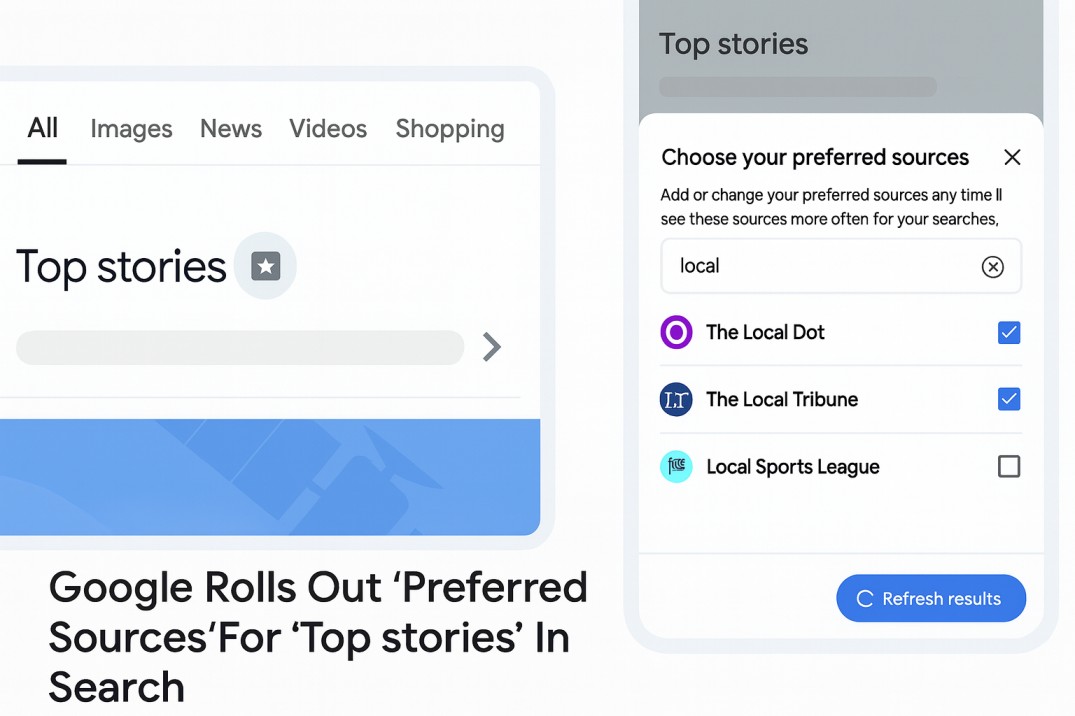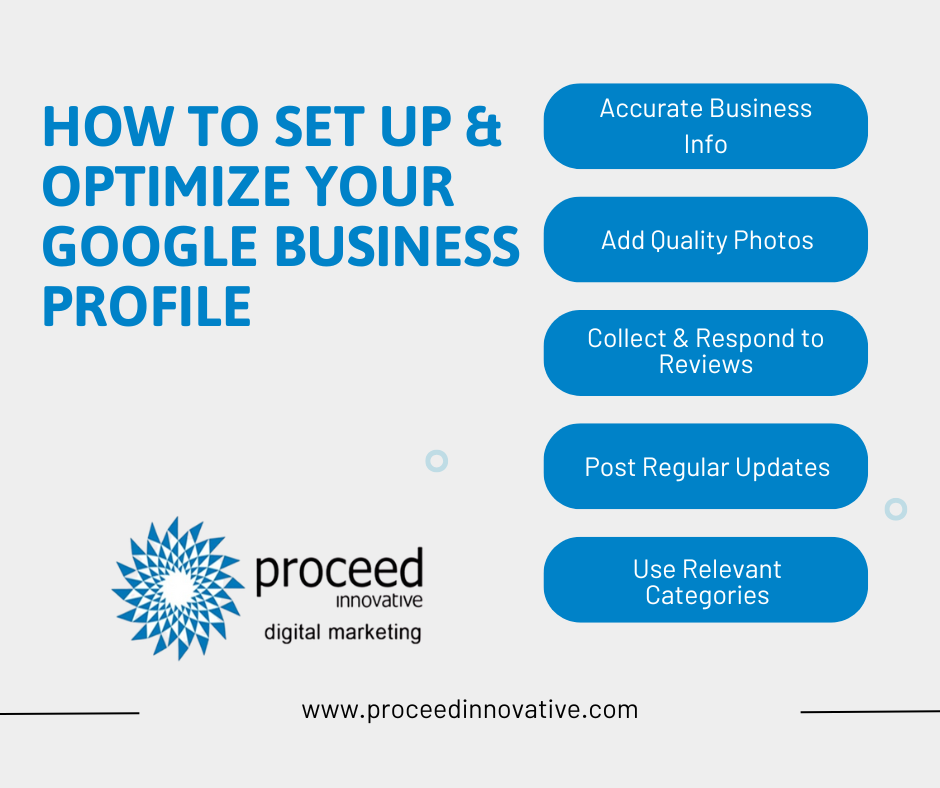Are you struggling to stand out in the crowded B2B market? Effective search engine optimization (SEO) is no longer just an option but a necessity for businesses aiming to gain a competitive edge. In this post, we’ll delve into the essentials of B2B SEO and how to develop a robust strategy that aligns with your brand’s goals.
We’ll guide you through conducting meticulous research for precise targeting and crafting a content strategy to elevate user experience. Discover how to optimize your website’s architecture and enhance on-page elements for better visibility. By reading on, you’ll learn to tackle common SEO challenges and use strategic link-building to solidify your market authority. Dive into this post and unlock the potential of B2B SEO to propel your brand to new heights.

Key Takeaways
- B2B SEO differs from B2C, focusing on industry-specific keywords and longer sales cycles
- Quality backlinking and industry engagement enhance domain authority and SEO success
- Regular SEO audits are vital for maintaining a credible and effective link profile
- Adapting to algorithm changes is critical for ensuring SEO strategies stay relevant and effective
- Analytics and KPIs drive SEO strategy adjustments and alignment with business goals
Understanding the Essentials of B2B SEO
In diving into the nuances of B2B SEO, you will recognize its transformative power for business growth. Defining B2B search engine optimization showcases methods for shaping your digital presence, tuned distinctly from B2C strategies, where elements like backlinking and content marketing all play pivotal roles. The strategic design of a landing page can act as a keystone in your digital marketing services architecture, supporting a robust digital marketing agency’s role in enhancing B2B visibility and lead generation.
Defining B2B SEO and Its Impact on Business Growth
In the landscape of digital commerce, B2B SEO stands as a critical component of a successful online strategy. Unlike its B2C counterpart, B2B SEO heavily relies on keyword research that targets industry-specific jargon and phrases used by professionals in the field. This is evident in the search engine results pages (SERPs), where ensuring visibility to a business-oriented audience can significantly spur growth and cement a company’s presence in its respective sector.
Moreover, elements like link building, intricately tied with Google Ads and email marketing, play a significant role in reinforcing a business’s relevance and authority in its niche. It is clear that the deliberate application of link building not only garners attention but also establishes a network of credibility, further amplified by effective Google Ads and strategic email marketing campaigns:
| SEO Component | Role in B2B Growth |
| Keyword Research | Targets industry-specific terms, improving SERP rankings |
| Link Building | Enhances domain authority and fosters industry relationships |
| Google Ads | Increases visibility, complements organic SEO efforts |
| Email Marketing | Nurtures leads and maintains engagement with a professional audience |
Key Differences Between B2B and B2C SEO Strategies
The main distinction between B2B and B2C SEO lies in the approach to marketing strategy and lead generation. While B2C focuses on high-volume traffic and quick conversion rates, B2B SEO places greater weight on developing meaningful relationships and nurturing leads. This process often involves a longer sales cycle, prompting a more in-depth competitor analysis and tailored content that addresses complex business challenges and solutions.
In B2B markets, advertising content must be highly targeted, leveraging precise keyword strategies that resonate with industry insiders and decision-makers who are searching the internet for specific solutions. Our strategy at Proceed Innovative always includes an emphasis on detailed, informative content that positions a brand as a thought leader, as this is fundamental in persuading organizations to opt for one solution over another in a competitive business landscape:
| SEO Focus Area | B2B Emphasis | B2C Emphasis |
| Marketing Strategy | Relationship-building, educational content | Broad appeal, emotional engagement |
| Lead Generation | Long sales cycle, nurtured leads | Quick conversions, high-volume traffic |
| Advertising Content | Highly targeted, industry-specific | General consumer appeal, wide-reaching |
| Competitor Analysis | In-depth, feature-focused comparison | Price and popularity comparison |
The Role of SEO in B2B Digital Marketing Agencies
SEO plays an integral role in shaping successful B2B digital marketing strategies. By utilizing tools like Google Analytics, we ensure that our clients’ budgets are allocated effectively, resulting in heightened brand awareness and increased revenue. Particular attention is paid to web design elements, optimizing them not just for aesthetics but for search engine visibility, thereby directly aligning with our clients’ goals for growth.
SEO isn’t just about boosting rankings; it’s about crafting an authoritative digital presence that resonates with a business’s target audience. When developing an SEO strategy, our aim is to establish a strong foundation for brand awareness. This paves the way for businesses to not only get noticed but also remain top-of-mind for their potential customers, which ultimately supports sustainable revenue streams and long-term partnerships.
Developing a Robust B2B SEO Strategy
As we forge ahead with crafting a robust B2B SEO strategy, we focus first on setting clear objectives aligned with business goals. This involves identifying your target audience and sketching out buyer personas, which provides a compass for our online advertising efforts. Understanding the landscape through thorough analysis of competitors uncovers opportunities for us to command attention. Integrating SEO with overall marketing plans is crucial, particularly when enhancing conversion rate optimization. These steps set the foundation for a comprehensive approach that elevates our B2B SEO impact.
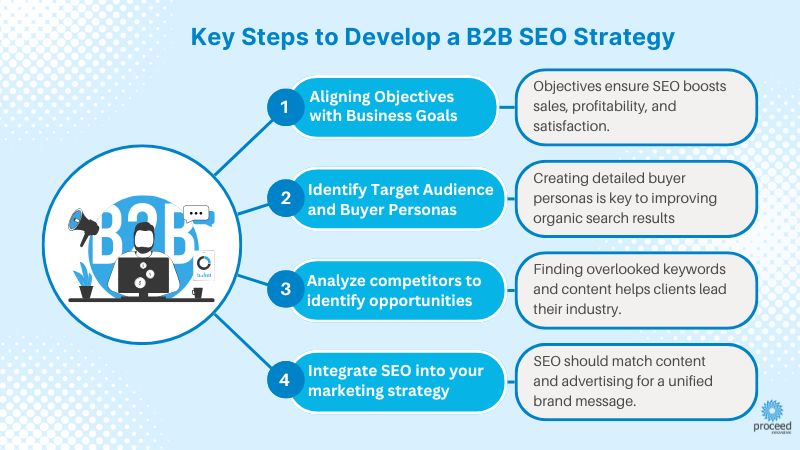
Setting Clear Objectives Aligned with Business Goals
Setting clear objectives is akin to plotting a course on a map: it defines the destination and charters a path to success. A focus on customer experience is key, as it determines the effectiveness of every touchpoint, whether through an omnichannel approach or a carefully optimized meta element. Framing objectives this way ensures that each SEO effort aligns with broader sales and marketing goals, ultimately refining the path to profitability and customer satisfaction.
When sketching out objectives, there should be a laser focus on measurable outcomes. This often involves progressing beyond traditional metrics to include factors like engagement depth and conversion influence. If, for example, our goal is to enhance the B2B sales process, the strategy might include refining meta elements for clarity, thus aiding in the seamless journey of a prospect from search to solution. With objectives rooted in tangible business goals, every SEO tactic employed has a clear purpose, directly serving the mission of growth and customer acquisition.
Identifying Target Audience and Buyer Personas
Identifying the target audience and creating detailed buyer personas is paramount to elevate organic search results. This critical step informs our web development and content management system strategies, allowing us to craft user experiences that resonate with the customers’ specific needs. By understanding who the customer is, we can tag content appropriately, optimizing for both the user and search engines, and thus drive a more qualified lead pipeline.
A thoughtfully designed tag system within a content management system can channel more specific, high-intent traffic to our clients’ B2B platforms. Personalizing content to address the pain points of each buyer persona leads to a more meaningful engagement, fostering trust and a higher chance of conversion. The aim is to ensure every piece of content we produce aligns seamlessly with the unique attributes and demands of the intended customer, upholding the integrity of their organic search journey.
Analyzing Competitors to Uncover Opportunities
In my approach to mastering B2B SEO, undertaking a methodical analysis of competitors offers countless opportunities. Through the meticulous collection of information via analytics tools, we comb through the online strategies that are winning on the world wide web. Specifically, we focus on how competitors rank on Google search, what keywords they dominate with, and the content that establishes them as thought leaders.
This strategic evaluation enables us to identify gaps in the market where our clients can carve out their own reputable space. While analyzing data, we often discover underutilized keywords or content strategies that can elevate our clients above their competitors, evolving them from followers to pioneers in their industry. These actionable insights, grounded in tangible analytics, shape a more informed and consequently powerful SEO strategy:
| SEO Analysis Focus | Competitor Benchmark | Opportunity Identified |
| Keyword Dominance | High-ranking industry terms | Potential niche keywords for differentiation |
| Content Leadership | Popular thought leader publications | Subjects for in-depth exploration or alternative viewpoints |
| Google Search Ranking | Top SERP positions | Improved metadata and on-page SEO for climbing ranks |
Integrating SEO With Overall Marketing Plans
When integrating SEO into our comprehensive marketing plans, our priority is ensuring each web page speaks to the persona it’s meant to engage with. By crafting URLs teeming with relevant keywords and data-driven content, this guides web crawlers to index our clients’ sites effectively, which dovetails with paid advertising and content strategies to create a cohesive brand narrative online.
The synchronization of SEO with overall marketing efforts is crucial. For instance, when a web crawler assesses a page, it’s because of the on-page elements, from meta tags to content, align with strategic keywords that resonate with our target audience. This level of integration ensures that every digital interaction is purposeful, driving meaningful traffic, and delivering on the promise of SEO as a potent tool in the arsenal of digital marketing.
Conducting Effective Keyword Research for B2B Markets
Mastering keyword research is a cornerstone of our B2B SEO strategy, driving success through carefully selected high-intent SEO marketing keywords. We delve into the power of long-tail keywords tailored for niche industries, optimizing our content creation with an eye for context and specificity. Leveraging advanced keyword tools, we conduct comprehensive analyses, ensuring our digital footprint aligns with the alt attributes we set, resonates with influencer marketing efforts, and outperforms in contextual advertising. Priority is given to keywords that maximize relevance and ROI, ensuring every facet of our marketing investment yields fruitful results.
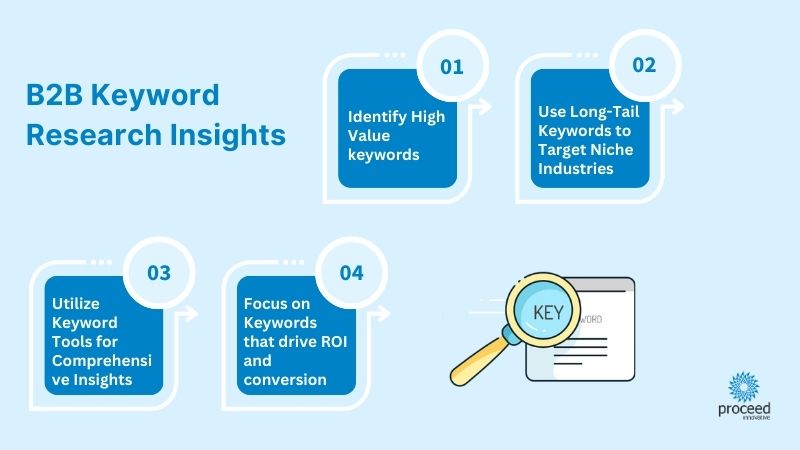
Discovering High-Intent SEO Marketing Keywords
Discovering high-intent SEO marketing keywords begins with a thorough understanding of the target audience’s language and pain points. By integrating accessibility into keyword research, we ensure content is not just visible but also resonates with the experience the lead is seeking. This rigor helps shape a design-centric SEO strategy that directly aligns with users’ needs, leading to higher engagement and conversion rates.
It is important to prioritize keywords that signal an intent to engage or purchase, rather than those that merely drive impressions. It is especially crucial to identify phrases that your target audience employs when they’re close to a decision-making point. The trick is in balancing broad appeal with precise targeting, creating an accessible yet focused path to the information that potential customers and leads value most.
Utilizing Long-Tail Keywords for Niche Industries
When exploring the intricacies of B2B markets, employing long-tail keywords is a powerful technique. These extended phrases, which are more specific than generic keywords, closely align with the detailed search queries of professionals. For example, a white paper that taps into a nuanced aspect of an industry’s needs will be more easily discovered if the content is infused with relevant long-tail keywords that mirror the sophisticated searches of niche audiences.
Adapting to the ever-evolving algorithm changes, like those affecting PageRank, requires a strategic approach to keyword optimization. It is recommended to use a sophisticated tool to identify long-tail opportunities, ensuring that every piece of content—be it a blog post, case study, or white paper—is tailored for maximum visibility and engagement within such specialized sectors:
- Identify key long-tail phrases that potential clients are using to find specific industry solutions.
- Integrate these phrases into high-quality, informative content designed to address the unique needs of the audience.
- Use metrics from SEO tools to refine the strategy continually, ensuring alignment with how algorithms index and rank pages.
Leveraging Keyword Tools for Comprehensive Analysis
To maximize return on investment (ROI) through targeted SEO strategies, we employ comprehensive analysis tools such as SEMrush. These resources are invaluable in gauging the effectiveness of current keyword strategies and uncovering fresh avenues for innovation and visibility. Tools like SEMrush not only offer insights into the SEO health of a website but also enable competitive analysis to see how well our content stacks up against others on search engines like Google and Microsoft Bing.

For instance, when we pinpoint keyword opportunities for a client in a specialized market, these tools facilitate deeper dives into search trends and user behavior. This analysis can reveal gaps in our strategy or highlight areas where we’re outperforming competitors, providing actionable data that ultimately boosts client presence in search results. By consistently leveraging technological advancements in keyword tools, we guarantee enhanced visibility and smarter data-driven decisions for our B2B partners:
- Analyze current keyword performance and identify areas for improvement to boost ranking on SERPs.
- Benchmark against industry peers to discover untapped keyword potentials and optimize for engines like Microsoft Bing.
- Adapt our strategies based on comprehensive data, maintaining an edge in markets where innovation directly translates to online success.
Prioritizing Keywords Based on Relevance and ROI
Choosing keywords with a spotlight on relevance and ROI boosts the efficiency of a B2B SEO strategy. This approach secures management’s backing by demonstrating an understanding of the business’s core values and offering a maximized ROI. Through meticulous selection, we focus on the phrases that enhance credibility in our industry, attract a targeted audience, and are more likely to convert, effectively lowering bounce rates and increasing the value of each visitor.
While developing a B2B SEO plan, we prioritize keywords proven to resonate with buyer personas. Not every keyword carries the same weight; some have the remarkable ability to drive both web traffic and meaningful interactions, signaling a well-aligned investment. By selecting these strategic keywords, we help our clients focus their resources on high-impact content that bolsters their online presence and fortifies their leadership within the industry.
Creating Valuable Content That Engages B2B Audiences
To excel in the B2B realm, we focus on creating content that not only addresses the pain points of businesses but also showcases expertise through case studies and whitepapers. By optimizing content for both search engines and users, we ensure that every piece is accessible and ranked well, from the domain name to each HTTP endpoint. This strategic content aligns with each stage of the buyer’s journey, incorporating cutting-edge trends like social media marketing and artificial intelligence.
Developing Content That Addresses Pain Points
When developing content aimed at search engine marketing, the priority is understanding and addressing the specific pain points of our B2B audience. Crafting precise descriptions that detail how automation can streamline an organization’s workflow demonstrates an intimate knowledge of their challenges. The right language in these descriptions can transform a page from a simple overview to a practical guide, thereby easing the path for businesses to recognize and engage with solutions.

Central to this approach is the integration of feedback loops in the content creation process, ensuring that the language and descriptions evolve with the evolving needs of organizations. For example, we often include real-world cases where automation has rescued companies from common inefficiencies. This not only reinforces the content’s value but also provides actionable insights, which, when reflected in the search engine results, elevate the organization’s decision-making process:
- Dissect an organization’s intricacies to tailor content that hits home on critical efficiency bottlenecks.
- Draft descriptions that resonate with the specific language and nuances of the industry, enhancing relevancy and search engine marketing effectiveness.
- Implement automation success stories to provide actionable insights and underscore the practical benefits of the featured solutions.
Incorporating Case Studies and Whitepapers
Incorporating case studies and whitepapers becomes a trove of knowledge, essential for demonstrating practical applications to potential clients. By showcasing data from web analytics within these documents, we provide a transparent view into the effectiveness of our offerings, addressing the concerns that lie within the funnel of converting interested audiences into loyal consumers.
Whitepapers and case studies serve not only to educate but also to differentiate us in a landscape rife with competition. These materials allow us to convey a depth of knowledge and insight into industry trends, directly speaking to the informed consumer with data-backed results that assert our solution’s superiority. This results in content that not only ranks well on search engines but also empowers decision-makers with valuable information:
| Content Type | Value Offered | Impact on SEO & Lead Gen |
| Case Studies | Demonstrates success with real-world examples | Enhances credibility and user engagement |
| Whitepapers | Provides in-depth analysis and expertise | Attracts high-quality leads through targeted keywords |
Optimizing Content for Search Engines and Users
Prioritizing the optimization of content for both search engines and users helps enhance B2B engagement. Avoiding duplicate content is crucial for SEO; it ensures each page offers unique value, thus avoiding penalization that hinders search engine rankings. Simultaneously, tailor content to address the specific challenges and objectives of our clients, making sure that every piece of information is actionable and directly relevant to their needs.
Integrating paid media strategies, such as Facebook advertising, into content creation underscores the importance of synergy between organic and paid channels. Each piece of content is developed with dual intent: to perform well in organic search rankings and to complement targeted paid media campaigns, ensuring a consistent and compelling message is conveyed across all platforms our clients engage with:
| SEO Strategy Element | Role in Content Optimization |
| Duplicate Content Avoidance | Increases unique value and search engine favorability |
| Paid Media Integration | Aligns organic and paid efforts for cohesive messaging |
| Facebook Advertising Support | Boosts content reach and complements SEO initiatives |
Aligning Content Strategy with Buyer’s Journey Stages
Aligning content strategy with each stage of the buyer’s journey stands as a cornerstone of success. This approach ensures that every piece of content directly caters to the evolving needs of prospects, from initial awareness through to decision-making, which is essential for effective sales enablement. It is important to focus on creating content that educates early-stage buyers while offering deeper insights to those on the cusp of purchase, enhancing the lead nurturing process.
As part of a strategy that leverages both organic search and paid advertising, it’s clear that when specific content mirrors the journey stages, the potential for conversion surges. It is important to continually refine content to not only attract attention but also to guide potential clients toward informed decisions. Essentially, every piece of content is a strategic touchpoint, designed to move users towards a sales conversation with the highest level of informed confidence.
Optimizing Website Architecture and on-Page Elements
Optimizing website architecture and on-page elements is essential to drive thought leadership, leads, and revenue growth for B2B businesses. Delving into site structure enhances crawlability and positions us as a full-service marketing force. Balancing this with on-page SEO best practices and ensuring mobile responsiveness contributes to fast load times—a must for retaining engagement with social content. The inclusion of schema markup further amplifies the message in search results with rich snippets, underlining our strategy’s vital role in transforming online presence into genuine business success.
Enhancing Site Structure for Better Crawlability
A well-structured website is a crucial performance indicator for B2B SEO success. Enhancing site architecture ensures search engines can crawl and index content seamlessly, which in turn, supports the leadership and reputation of a B2B brand. Through optimizing usability and clarity in site design, prioritize clear navigation paths and logical hierarchies, integrating comprehensive metadata that accurately reflects the content of each page.
In the realm of B2B online engagement, usability and metadata are not mere technical details; they’re reflections of a brand’s commitment to providing value. By structuring metadata with precision—carefully crafting title tags and meta descriptions—aims to improve organic search performance and elevate the user experience. This meticulous approach fortifies a business’s online reputation, signaling a dedication to quality and accessibility that resonates with professional audiences.
Implementing on-Page SEO Best Practices
Optimizing on-page SEO involves a careful crafting of content that both search engines and users find valuable. For instance, when including an infographic explaining a complex technology concept, it enhances understanding for the reader while also appealing to search engines, given the content’s rich media engagement potential. By embedding alt attributes rich in contextually relevant keywords, these elements become not just visually appealing but also SEO assets, increasing the page’s visibility and user engagement.
Implementing structured data, such as XML sitemaps, facilitates search engines in indexing the site content more effectively. It’s not just about the sitemaps, though; on every page, prioritize relevance and keyword integration within the text. This methodological embedding of keywords, combined with practical examples and clear, straightforward explanations, guarantees that the content remains accessible and ranks well. These on-page enhancements result in improved search rankings and user experience:
- Integrating infographics with SEO-focused alt text to yield better understanding and interaction.
- Embedding XML sitemaps that guide search engines through the site, improving indexing and search visibility.
- Incorporating keyword-rich descriptions to podcast episodes, delivering both relevancy and value to our audience.
Ensuring Mobile Responsiveness and Fast Load Times
When enhancing a site’s architecture, mobile responsiveness is indispensable to meet the evolving browsing habits of the B2B target market. Rapid load times and an adaptable interface are non-negotiable to prevent potential leads from bouncing, which ultimately influences the cost per lead. Each element of design from responsive images to fluid grid layouts is meticulously crafted to ensure content is easily accessible, whether viewed on a desktop or a smartphone, enhancing both user experience and SEO performance.
Addressing the technicalities of website speed, focus on optimized code and avoid any unnecessary elements that could weigh down the site’s performance. Not only does this prevent the alienation of social media-savvy visitors, but it also aligns with search engines’ growing emphasis on user experience as a ranking factor. Streamlining code and assets improves efficiency, steering clear of practices like spamming that can hamper search visibility and degrade the credibility of a B2B site.
Utilizing Schema Markup for Rich Snippets
Incorporating schema markup for rich snippets can profoundly amplify a Google Business Profile. Such structured data distinctly molds the way information is displayed in search results, making it crucial for standout appearances on search engines. By steering clear of spamdexing tactics and focusing on true optimization, we can ensure that rich snippets enhance the visibility and click-through rates for B2B clients, further solidifying their credibility and appeal.
Diligently conducting an SEO audit on a website illuminates the undeniable benefits of schema markup in contextualizing data for search engines. When utilized effectively, rich snippets derived from schema provide a clear and informative synopsis of the content, giving users a snapshot that can succinctly answer their queries. This level of optimization has repeatedly proven to drive targeted traffic and increase the relevance of a site in the dense digital ecosystem of engine marketing.
Building Authority Through Strategic Link Building
Building authority is crucial for a successful B2B marketing campaign. A fundamental component of this is earning quality backlinks from industry websites, which signals to search engines like Google that the site is a valuable resource. Additionally, networking with influencers and thought leaders, engaging in guest posting and content collaborations, and monitoring backlink profiles are vital for quality assurance. As we delve into these strategies, we will illustrate how they enable elevated success and leverage tools for seamless integration into our SEO tactics.
Earning Quality Backlinks from Industry Websites
Earning quality backlinks from respected industry websites significantly bolsters the link profile of a business. This strategy serves as a core pillar of SEO marketing strategy, reinforcing domain strength and signaling relevance to search engines. By focusing on creating compelling and shareable content, you can actively engage with industry platforms to secure these crucial backlinks, which are vital for both local SEO and wider SEO optimization gains.
Approaching link building with precision, tailor your outreach to align with a SEO marketing vision that emphasizes value and partnership. Establishing connections with authoritative industry voices not only enhances SEO marketing strategies but also fosters a community around shared expertise. This strategy can improve site authority and supported robust SEO optimization, directly influencing search engine rankings:
| SEO Factor | Contribution to Link Building |
| Quality Backlinks | Enhances domain authority and credibility |
| Industry Engagement | Fosters partnerships and community building |
| SEO Marketing Strategy | Drives targeted improvements in SERPs |
| Local SEO | Amplifies regional visibility and reach |
Networking With Influencers and Thought Leaders
Collaborating with influencers and thought leaders within the industry can have a positive impact on a B2B marketing campaign. This approach not just enhances the SEO marketing effort, but also solidifies your standing in the agile sphere of B2B digital authority. By engaging with these pivotal figures and integrating their insights into your content, you can provide a depth of knowledge that both search engines and audiences respect and trust.
Engaging in Guest Posting and Content Collaborations
Engaging in guest posting and content collaborations offer a dual benefit: they bolster your content marketing strategy while providing precious inbound links that enhance demand generation. Sharing expertise on reputable platforms reaches a wider audience.
Furthermore, forming alliances through content collaborations enriches content marketing strategies with diverse perspectives and insights. This tactic has proven effective in shoring up domain authority, as the content resonates deeply with the complexities and nuances of our target market. Engaging in these strategic partnerships can have a tangible impact on the depth and quality of our engagement, driving meaningful conversations and conversions in a highly competitive marketplace.
Monitoring Backlink Profiles for Quality Assurance
Monitoring backlink profiles is not just about quantity but quality assurance. Routine SEO audits play an essential role in this process, helping to identify and weed out undesirable links that could harm the site’s organic SEO performance. It’s crucial to remain vigilant in ensuring each backlink aligns with your SEO content strategy, maintaining a profile that search engines trust and reward.
Implementing rigorous monitoring of backlink profiles also reinforces SEO content marketing efforts. Organic SEO thrives when paired with high-quality links that echo the integrity of our strategy. Engaging in a thorough examination of the backlinks, the goal is to provide a valuable layer of credibility to the overall SEO approach:
- Conducting an SEO audit regularly to identify and address weak or harmful links.
- Aligning backlinks with SEO content strategy to bolster organic search rankings.
- Ensuring each link is a testament to the quality and relevance of SEO content marketing.
Measuring Success and Refining B2B SEO Strategies
A good BSB SEO strategy includes rigorously tracking Key Performance Indicators (KPIs) and diving deep into analytics for actionable insights. It is important to adjust strategies based on data-driven findings to enhance marketing communications and ensure the content remains at the cutting edge of SEO trends and algorithm changes. Through these practices, every aspect of your SEO—be it a meticulously crafted newsletter, an intricate HTML structure, or an innovative concept—is geared for success.
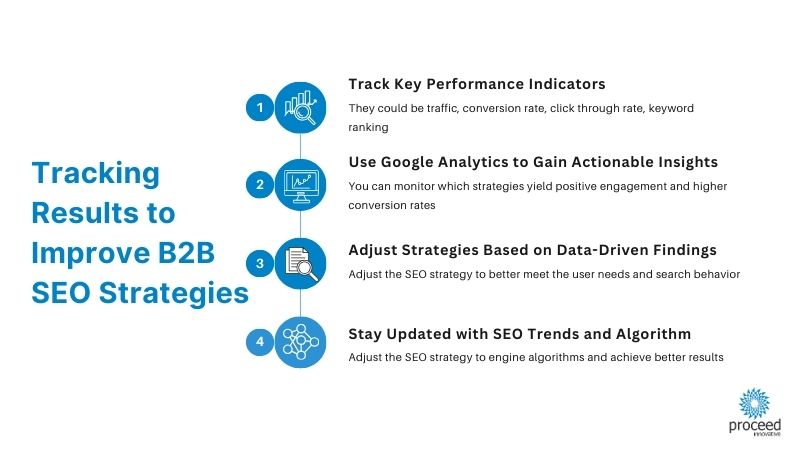
Tracking Key Performance Indicators (KPIs)
Constantly monitoring key performance indicators helps to understand how effectively your strategies are performing. Tracking metrics like the number of new email addresses captured through the site’s lead forms, indicates improvements not just in traffic, but in generating quality leads too. Establishing relevance in local search and adhering to white hat practices are fundamental to the long-term success of B2B marketing, and these KPIs help evaluate and refine the approach continuously.
Furthermore, measuring KPIs provides invaluable insight into where you need to adjust your strategies for better results. If a particular set of keywords is not driving the expected level of engagement, it’s a signal to delve deeper into optimization. Monitoring these indicators gives the ability to sustain a high level of expertise and ensures that every SEO decision made is backed by solid analytics.
Using Analytics to Gain Actionable Insights
Leveraging analytics is essential to transform raw data into actionable insights that can refine our B2B SEO strategies. By examining user behavior, including interactions with software platforms, and responses to our call to action, I gain a nuanced understanding of what resonates with clients across the United States. This knowledge allows me to adjust tactics, steering clear of black hat techniques that violate search engine guidelines, and solidifying trust with our users.
Utilizing analytics tools also helps track the performance of specific content pieces and SEO activities. You can monitor which strategies yield positive engagement and higher conversion rates, identifying patterns in the data to proactively enhance future campaigns. Our focus remains on maintaining a suite of white hat SEO techniques while tuning our messaging and call to action to meet the specific demands and behaviors of our target audience, fostering a foundation for sustained SEO success.
Adjusting Strategies Based on Data-Driven Findings
In the dynamic field of B2B search engine optimization, adjusting strategies based on business intelligence and data-driven findings is essential. Analytics must be scrutinized to understand user behavior better, to optimize for search engines more effectively, and to ensure that strategies are robustly aligned with business goals.
When we observe shifts in user engagement or fluctuations in search engine rankings, we pivot promptly. We leverage business intelligence to inform our decisions, allowing us to refine everything from keyword focus to content distribution channels. This adaptation is a cycle of continuous improvement:
- Analyze the performance metrics against business objectives.
- Employ business intelligence tools to uncover the underlying trends.
- Adjust the SEO strategy to better meet the user needs and engine algorithms.
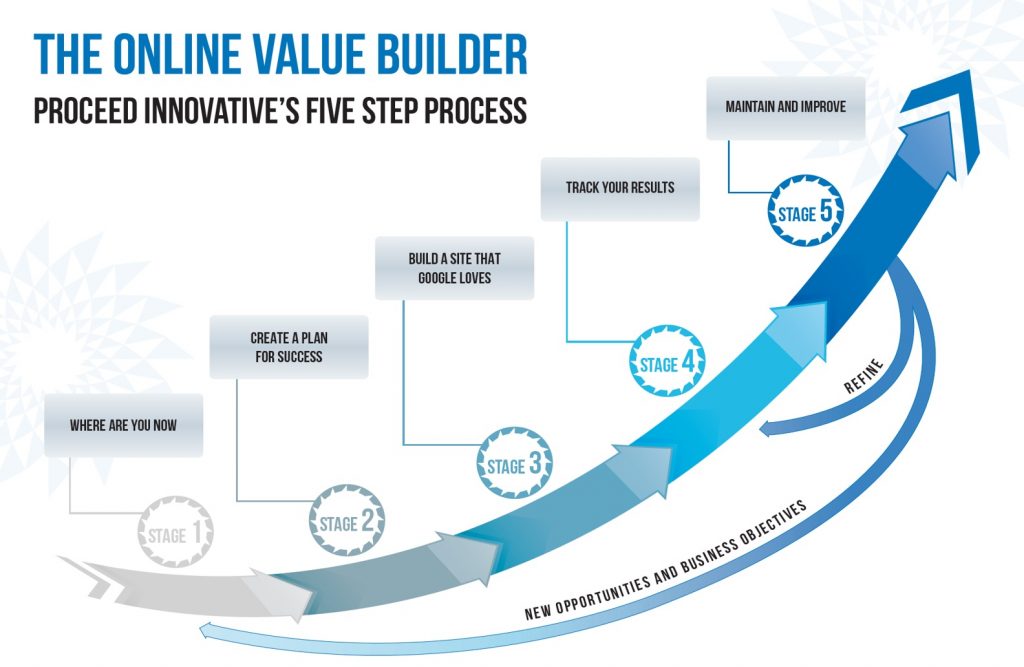
Staying Updated with SEO Trends and Algorithm Changes
Staying abreast of the latest trends and algorithm changes is not just a task—it’s a continuous journey of learning. It is important to adapt to the evolving landscape, where user intent and the intricacies of software development directly influence our tactics. Aligning our strategies with these advancements ensures that our SEO efforts remain congruent with our primary goal of driving meaningful business outcomes.
 Frequently Asked Questions
Frequently Asked Questions
What are key elements in a B2B SEO strategy?
Key elements in a B2B SEO strategy include keyword research tailored to business customers, high-quality content that addresses their specific pain points, and a robust backlink profile to build domain authority.
How does keyword research differ for B2B markets?
Keyword research for B2B markets requires a focus on niche, industry-specific terms and longer, more detailed keywords indicative of users with specialized knowledge seeking in-depth solutions.
What types of content best engage B2B audiences?
Engaging B2B audiences often hinges on creating content that is informative, industry-relevant, and actionable, with case studies, whitepapers, and webinars ranking highly for delivering value and fostering engagement.
How can website architecture improve B2B SEO?
Strategic website architecture furthers B2B SEO by ensuring crawl efficiency, enhancing user experience, and creating a logical flow for content, which all work synergistically to boost search engine rankings and facilitate lead generation.
How do you measure the success of a B2B SEO strategy?
The success of a B2B SEO strategy is measured by increased organic traffic, higher SERP rankings, quality lead generation, and boosted conversion rates, reflecting improved visibility and engagement with the target business audience.
Achieve B2B SEO Marketing Success with Proceed Innovative
Mastering B2B SEO is essential for establishing and reinforcing a brand’s digital presence and credibility within its industry. By employing strategic keyword research, creating valuable content, and optimizing all aspects of website architecture, businesses can engage more effectively with their target audience and drive meaningful conversions. The proactive monitoring and adjustment of SEO strategies based on analytics and staying attuned to the latest trends are crucial for sustained success. In the competitive landscape of B2B marketing, a well-crafted SEO strategy proves to be a significant differentiator, underpinning long-term business growth and success.
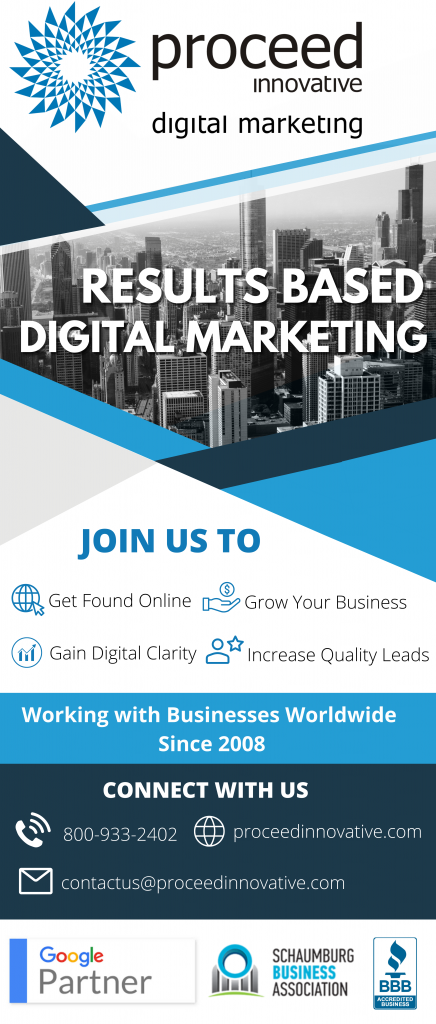
If you want to improve your B2B SEO marketing efforts to being your business to new heights, our professionals at Proceed Innovative can help. We are a full-service digital marketing agency that provides SEO marketing services to help businesses improve their online presence and get more business opportunities online. We have developed successful B2B marketing strategies for our clients using proven methods and consistently monitoring the performance to ensure the best possible results.
You can call Proceed Innovative at (800) 933-2402 or submit a contact form to learn more.


 Frequently Asked Questions
Frequently Asked Questions